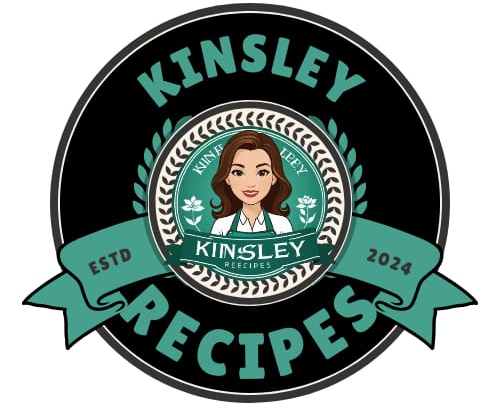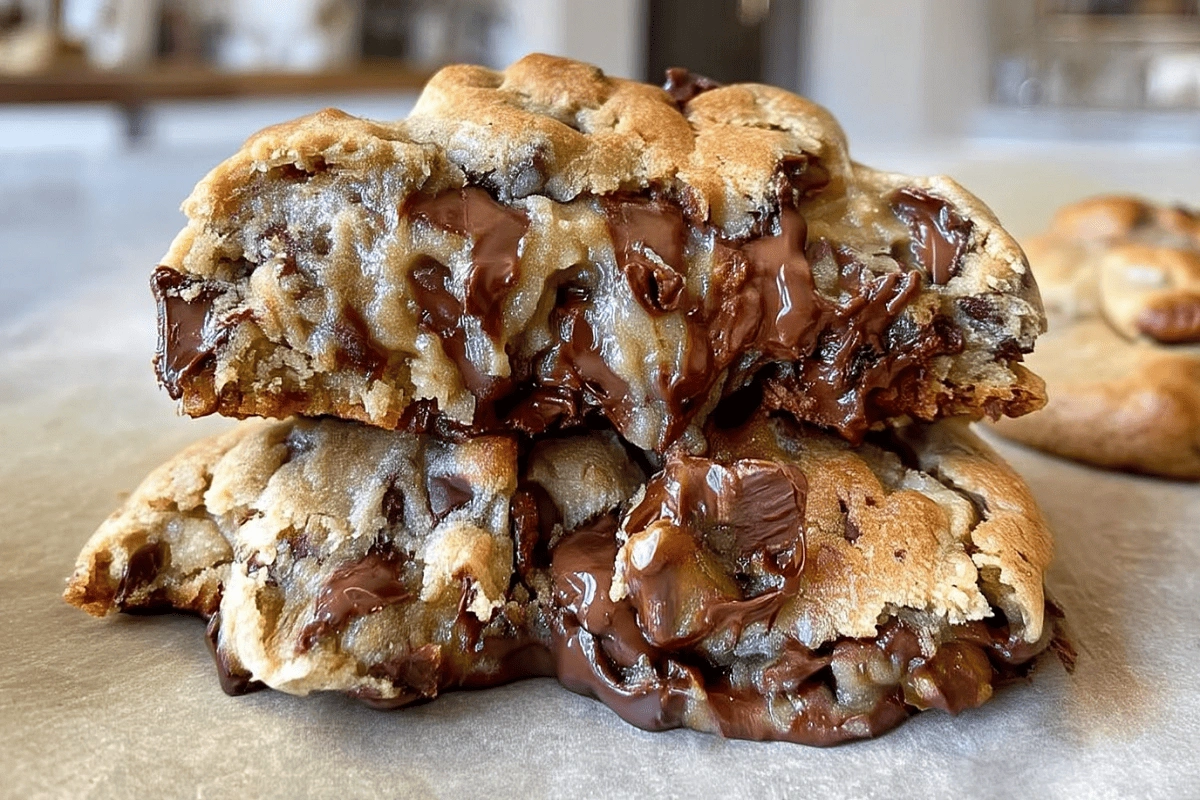Chocolate Chip Cookies – The Ultimate Guide to Gooey, Thick & Perfect Bakes
There’s no dessert more beloved than chocolate chip cookies. From late-night cravings to childhood memories, these cookies have earned their place as a classic. But there’s a big difference between basic chocolate chip cookies and the kind that make people ask for the recipe after just one bite.
This guide will walk you through everything you need to make the best chocolate chip cookies ever thick, golden, and filled with gooey chocolate centers. With smart techniques like using cold butter, a short high-heat bake, and a pinch of cornstarch, you’ll get those crisp edges and soft, melty middles every time.
We’ll also break down why cookies spread, what to do when they don’t, and how to freeze your cookie dough like a pro. Whether you’re baking for friends, gifting, or just treating yourself, this chocolate chip cookies recipe is a game changer.
Check out our Strawberry Sugar Cookies if you’re into fruity, allergy-friendly cookies too.
What Makes the Perfect Chocolate Chip Cookie?
The Anatomy of the Ultimate Cookie: Texture, Flavor, and Structure
A truly perfect chocolate chip cookie hits three marks: chewy inside, crisp on the outside, and loaded with chocolate. Achieving this dreamy trifecta comes down to your ingredients, temperature, and baking time not just the recipe itself.
The ideal cookie should be:
-
Thick and gooey in the center
-
Crisp at the edges
-
Rich in chocolate with balanced sweetness
-
Slightly chewy but not dry or cakey
This recipe does just that. With cold butter, high-temperature baking at 475°F, and a few small tweaks, you’ll get bakery-style chocolate chip cookies that are ready in under 10 minutes.
Why Cold Butter and High Heat Make a Huge Difference
Unlike soft butter methods that cause over-spread, using cold butter slows the melt, keeping cookies thick. Baking at a high temp lets the exterior firm up fast while the inside stays gooey and soft.
Combined with a spoonful of cornstarch, the texture becomes incredibly tender but never cakey. It’s the ultimate hack for soft, chewy chocolate chip cookies that still hold their shape.
Don’t miss our S’mores Brownies – The Best Gooey Dessert if you crave more rich, gooey bakes.
Print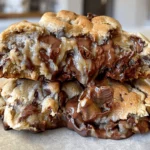
Chocolate Chip Cookies – Best Gooey Recipe Ever (2025)
- Total Time: 17 minutes (automatically calculated as Prep + Cook)
- Yield: 10–12 large cookies 1x
- Diet: Vegetarian
Description
🍪🔥 The Best Chocolate Chip Cookies EVER — thick, chewy, golden on the outside, and absolutely melting with chocolate on the inside!
This recipe uses cold butter, cornstarch, and a high 475°F bake to give you crispy edges with an ultra-soft, gooey center. Just 6–7 minutes in the oven and they come out perfect every single time. 🍫✨
Ingredients
-
1¼ cups (150g) all-purpose flour
-
3 tbsp cornstarch
-
½ tsp baking soda
-
½ tsp salt
-
½ cup (113g) cold unsalted butter, cubed
-
6 tbsp granulated sugar
-
6 tbsp brown sugar
-
1 large egg
-
½ tsp vanilla extract
-
10–11 oz chocolate chips (mix of dark and semi-sweet recommended)
-
Optional: ¼ cup chopped walnuts
Instructions
-
Preheat oven to 475°F (246°C). Line a baking sheet with parchment paper.
-
In a medium bowl, whisk together flour, cornstarch, baking soda, and salt.
-
In a large mixing bowl, cream the cold butter, granulated sugar, and brown sugar until creamy (2–3 minutes).
-
Beat in the egg and vanilla until fully combined.
-
Gradually add the dry ingredients into the wet mixture. Mix until just combined.
-
Fold in the chocolate chips and optional walnuts.
-
Scoop large dough balls (~2–3 tablespoons each) and place on the prepared tray.
-
Bake for 6–7 minutes until the edges are golden and centers appear soft.
-
Cool on tray for 10 minutes before transferring. Enjoy warm!
Notes
-
For extra gooey centers, slightly underbake the cookies and let them finish setting on the tray.
-
Use cold butter (not softened) to help the dough hold its shape during baking and prevent over-spreading.
-
Want taller cookies? Chill the dough for 30–60 minutes before baking, or overnight for maximum flavor.
-
Scoop dough generously for thick, bakery-style cookies. A 3-tablespoon cookie scoop is ideal.
-
Press extra chocolate chips into the tops before baking for a glossy, melt-in-your-mouth finish.
-
For a twist, add walnuts or pecans for texture, or swirl in a tablespoon of peanut butter.
-
Dough freezes well: scoop onto a tray, freeze solid, then transfer to freezer bags. Bake directly from frozen, adding 1–2 minutes to bake time.
- Prep Time: 10 minutes
- Cook Time: 7 minutes
- Category: Dessert, Cookies
- Method: Baking
- Cuisine: American
Nutrition
- Serving Size: 1 large cookie
- Calories: 210 kcal
- Sugar: 16 g
- Sodium: 105 mg
- Fat: 10 g
- Saturated Fat: 6 g
- Unsaturated Fat: 3 g
- Trans Fat: 0 g
- Carbohydrates: 28 g
- Fiber: 1 g
- Protein: 3 g
- Cholesterol: 30 mg
Keywords: Chocolate Desserts, Cookie Recipes, Easy Baking Ideas, Viral Cookie Recipes, Soft & Chewy Cookies, Family Favorite Treats, High-Heat Baking, Snack Ideas, Classic American Desserts
Ingredients Breakdown for Thick & Gooey Chocolate Chip Cookies
The Role of Cornstarch, Cold Butter, and High Baking Temps
When it comes to baking thick, gooey chocolate chip cookies, your ingredient choices and ratios are everything. This recipe is engineered for texture—with cold butter, cornstarch, and high heat creating a perfectly balanced cookie that’s crisp outside and soft inside.
Here’s why these ingredients matter:
-
Cold Butter: Unlike softened butter, cold butter slows down melting in the oven. That means your cookies stay tall and thick rather than spreading into thin puddles. Cube it straight from the fridge and beat it directly into the sugars for best results.
-
Cornstarch: Acting as a tenderizer, just a few tablespoons of cornstarch softens the dough without compromising chewiness. It’s one of the secrets to that melt-in-your-mouth center you love in bakery-style chocolate chip cookies.
-
High Baking Temp (475°F): Traditional cookie recipes use 350°F–375°F. But this one blasts the dough at a hotter temperature for a shorter time. That sets the edges quickly while preserving a gooey center.
-
Sugars: A combo of brown and white sugar is essential. Brown sugar adds moisture and depth of flavor, while granulated sugar gives crispness and structure.
-
Egg & Vanilla: One egg provides the perfect binding and lift, while vanilla extract enhances sweetness and depth.
Discover great ideas like these Heavenly Raspberry Cheesecake Cupcakes for more rich, soft-baked treats.
Chocolate Chips vs. Chunks vs. Discs: What’s Best?
Not all chocolate is created equal. Here’s a quick breakdown to help you decide:
| Chocolate Type | Melts Well | Pools of Chocolate | Classic Look | Best For |
|---|---|---|---|---|
| Chips | ❌ Medium | ❌ Rare | ✅ Yes | Traditional Cookies |
| Chunks | ✅ Yes | ✅ Yes | ✅ Some | Gooey Center Cookies |
| Discs/Wafers | ✅ High | ✅ Pools Everywhere | ❌ No | Gourmet Cookies |
For truly gooey, chocolate-dense bites, use a mix of chocolate types. Try 1 cup chips + ½ cup chunks for the perfect balance of texture, melt, and visual appeal.
Learn more about balanced sugar-to-fat baking strategies in our Strawberry Kiss Cookies a lighter spin on a chewy classic.
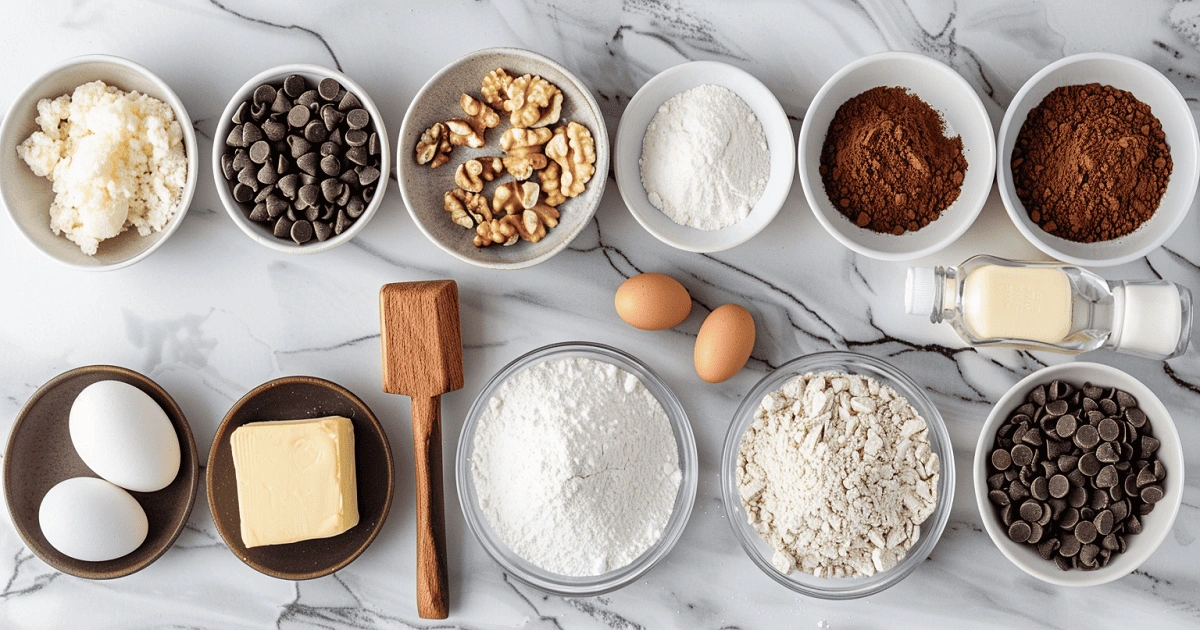
Step-by-Step Chocolate Chip Cookie Recipe
Dough Engineering: Building Texture with Purpose
Creating the perfect chocolate chip cookie starts with understanding how ingredients interact at a molecular level. This isn’t just mixing flour and sugar this is structured texture building. In this recipe, every component has a function beyond flavor:
-
Cold butter isn’t just about convenience it slows down the spread, giving cookies a controlled rise before fat liquefaction sets in. This allows for thicker, bakery-style cookies without a chill step.
-
Cornstarch acts as a softening agent, binding water and fat while interrupting gluten formation. It gives the interior that desirable chew without compromising structure.
-
High-protein flour (standard all-purpose, 11–12% protein) provides enough gluten development to lift and hold the dough during the high-temperature bake.
-
Dual sugar ratios (equal parts brown and granulated) manipulate moisture retention and caramelization: brown sugar contributes molasses-driven chew and depth, while white sugar promotes edge crisping and lift.
Mixing Mechanics: Precision in Process
-
Creaming cold butter with sugar at high speed is non-traditional but intentional. You want a slightly chunky, emulsified base that resists over-aeration. This ensures the cookies rise vertically rather than spreading outward.
-
The egg must be fully incorporated, not just for emulsification, but to regulate steam generation and moisture during the short, high-temp bake.
-
Dry ingredients are folded in gradually to minimize gluten overdevelopment. This maintains tenderness while ensuring cohesion in the dough matrix.
-
Chocolate chip integration should be deliberate. Mixing by hand at this stage reduces friction heat, preventing the dough from warming and triggering premature fat softening.
Optional add-ins like walnuts offer more than crunch they interrupt the dough structure, creating asymmetrical rise and adding complexity to the bite.
Why a 475°F Oven Produces Superior Cookies
The cornerstone of this method is the high-heat bake 475°F may seem aggressive, but it’s backed by thermodynamic logic. Here’s what it achieves:
-
Maillard reaction acceleration: Browning begins faster, intensifying flavor on the cookie’s surface.
-
Edge setting: The exterior firms within 2–3 minutes, locking the spread radius and maintaining height.
-
Interior tenderness: The center remains thermally insulated, producing that gooey, molten core without rawness.
Timing is critical: 6–7 minutes is your sweet spot. The cookies should emerge with lightly bronzed edges and soft centers that finish cooking from residual heat. Transfer them only after a 5-minute tray rest this is where starches set, fats reabsorb, and structure stabilizes.
This isn’t a basic recipe it’s a precision build for chewy, thick chocolate chip cookies with bakery-level results in under 10 minutes. You don’t need professional equipment just intention behind every step.
Don’t miss our Banana Bread Bars with Brown Butter Frosting for another masterfully layered dessert that balances texture and flavor.
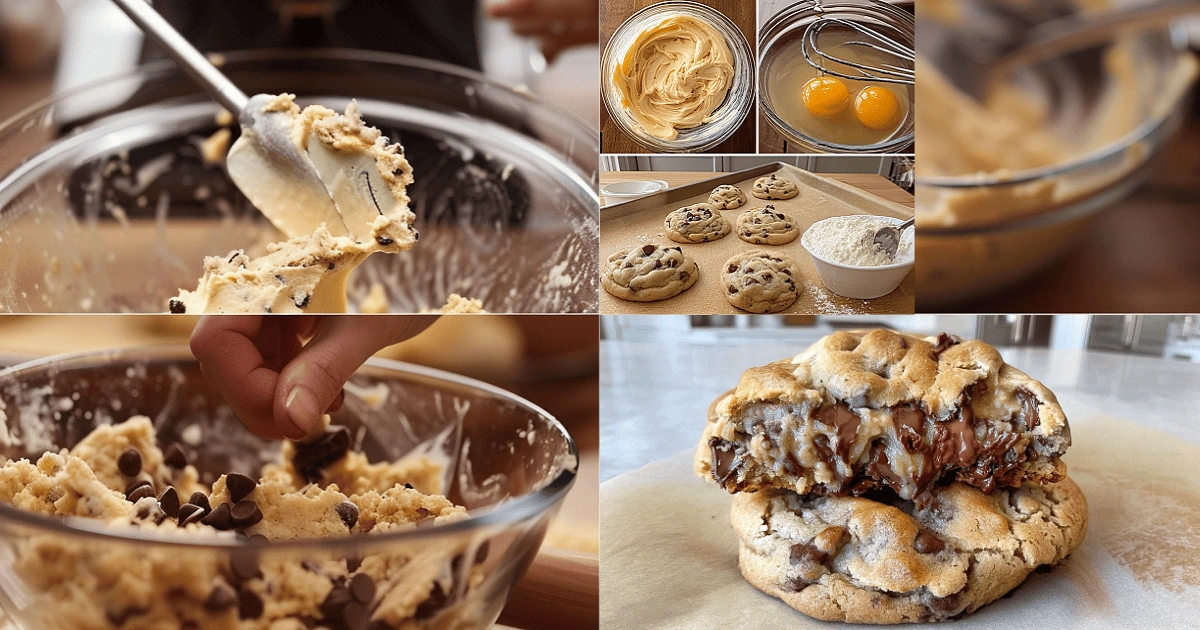
How to Make Gooey Chocolate Chip Cookies Every Time
The Science Behind the Gooey Center
Gooey chocolate chip cookies aren’t about underbaking they’re about thermal control, fat behavior, and starch-to-liquid ratios. The secret to that luscious, melt-in-your-mouth interior is a calculated contrast between a crisp outer shell and a just-set center. To get it right, every step from mixing to baking must work in sync.
Here’s how the technique used in this recipe ensures that gooey center:
-
High-temperature baking (475°F) flash-sets the outer crust through fast Maillard browning, while the interior is protected by residual dough moisture and insulated air pockets.
-
Cornstarch softens the crumb, interrupting gluten formation just enough to retain chew without breaking structural integrity.
-
Cold butter delays early spread, helping to keep thickness at the core where heat penetrates more slowly.
Together, these elements slow down the center’s bake rate, resulting in a gooey, molten texture that stabilizes during the cooling period.
Pro Tips for Consistent Gooey Results
Even if you’ve nailed the recipe, maintaining consistency from batch to batch comes down to baker behavior. Here are key adjustments you can make:
1. Size Matters
Use a medium to large scoop (2–3 tablespoons) to create cookies thick enough to support a soft center. Smaller scoops bake too fast, risking a dry, cakey texture.
2. Shape the Dough Strategically
Roll dough into tall cylinders, not flat balls. This gives the dough height and mass, which helps protect the center during baking. Think muffin top, not pancake.
3. Tray Resting Is Non-Negotiable
Remove cookies from the oven when they look underbaked in the center. Let them rest on the tray for 5 minutes. This “carryover bake” lets the internal structure set without additional heat from the oven.
4. Humidity & Butter Type
If your kitchen is dry or you’re using higher-moisture European butter, slightly reduce the flour (by 1 tablespoon) to keep moisture balance. This is a small but powerful tweak for achieving gooeyness.
5. Don’t Skip the Cornstarch
Even a tablespoon makes a difference. Cornstarch slows starch gelatinization, allowing the cookie to bake through without drying out the center.
Don’t miss our No-Bake Mini Banana Cream Pies if you love desserts that deliver rich texture without overbaking.
Why Do Cookies Spread & Flatten?
Understanding the Science Behind Spread
If your chocolate chip cookies are turning into pancakes in the oven, don’t panic. Cookie spread is usually caused by temperature imbalances or ingredient proportions that affect how fat and structure behave during baking.
Let’s break down the most common reasons:
1. Butter Temperature
Using melted or overly soft butter can cause cookies to spread too fast before the structure sets. Stick to cold butter or slightly softened at most—this keeps the dough tall and chewy.
2. Low Protein Flour or Too Little Flour
Under-measuring flour (especially when scooped loosely) weakens the dough’s ability to hold shape. Always spoon and level your flour or weigh it (1¼ cups = 150g for most all-purpose flours).
3. Hot Baking Sheets
Baking on a preheated sheet causes the bottoms to spread before the dough even settles. Always start with room temperature sheets and line them with parchment for consistent bakes.
4. Too Much Sugar or Baking Soda
Sugar liquefies in the oven and spreads the dough. Too much sugar = thin, lacey cookies. Baking soda can do the same when overused—it increases spread and browning too quickly.
How to Fix It for Bakery-Style Cookies
-
Use cold butter straight from the fridge, cubed for easier mixing.
-
Chill your dough at least 1 hour — 2½ hours for max control.
-
Line trays with parchment, not silicone (which traps more heat).
-
Bake at high heat (475°F) to set the edges quickly.
These fixes ensure you get those thick, soft, golden cookies you crave.
Want a deeper look into how baking temperature and butter consistency can impact spread? Read this insightful post from King Arthur Baking on why cookies spread in the oven — it breaks down the science beautifully.
Learn more about dough control techniques in our Strawberry Kiss Cookies, where spread is managed for crinkle-top perfection.
Pro Insight: Butter Behavior by Brand
Not all butter melts equally. European-style butters (like Kerrygold) have higher fat content and may spread more. Adjust your flour by 1–2 tablespoons or chill longer when using these.
Why Didn’t My Cookies Flatten?
Flat Isn’t Always Failure — But Sometimes It Is
While the trend has shifted toward thick chocolate chip cookies, a cookie that refuses to flatten can be just as problematic as one that spreads too far. Instead of gooey centers, you get doughy cores or overly domed, cakey textures. This often leaves bakers asking: Why are my cookies staying thick and puffy, without that signature crinkle and edge spread?
The answer lies in ingredient imbalance, mechanical mixing errors, and environmental variables.
5 Reasons Your Cookies Didn’t Flatten — And How to Fix Them
1. Too Much Flour
-
Cause: Over-measured flour leads to a dry, stiff dough with too much gluten.
-
Fix: Measure using the spoon-and-level method. Avoid compacting flour by scooping directly from the bag. If the dough looks crumbly, add 1 tsp of milk at a time until pliable.
2. Under-Creamed Butter and Sugar
-
Cause: Creaming incorporates air that expands during baking. If you skip or rush this step, your cookies will rise slowly and lack spread.
-
Fix: Beat cold butter and sugars for a full 2 minutes, until slightly fluffy and cohesive. Don’t shortcut this.
3. Not Enough Sugar
-
Cause: Sugar liquefies and spreads as it melts. Skimping reduces the spread and browning reaction.
-
Fix: Stick with the base ratio: 6 tbsp white + 6 tbsp brown sugar per 1¼ cups of flour. Reducing sugar alters texture dramatically.
4. Oven Temperature Is Too Low
-
Cause: A cooler oven allows structure to set before spreading begins.
-
Fix: Always bake at 475°F in this recipe. Use an oven thermometer to verify accuracy. A 25°F variance can ruin a batch.
5. Cookie Dough Was Too Cold
-
Cause: Over-chilling dough leads to excessive resistance during baking.
-
Fix: If you chilled the dough, let it sit at room temp for 10 minutes before scooping to allow partial softening.
Check out our Strawberry Sugar Cookies to see how subtle tweaks to dough texture impact spread and finish.
Can You Bake Chocolate Chip Cookie Dough From Frozen?
Why Freezing Dough Is a Pro Move
One of the most underrated tools in a baker’s toolkit is frozen cookie dough. Not only does it allow for fresh, on-demand cookies in under 10 minutes, but it actually enhances texture and flavor. As the dough rests in the freezer, it undergoes subtle hydration shifts and flavor development giving you chocolate chip cookies with a richer, deeper taste and controlled spread.
Freezing also gives you flexibility. Make a double batch once, and enjoy perfect cookies any time you want fresh from the oven, gooey center and all.
How to Freeze Cookie Dough (the Right Way)
Follow these professional steps to ensure frozen dough bakes evenly and deliciously:
1. Scoop Before You Freeze
Scoop dough into balls (2–3 tbsp each), then place them on a lined baking sheet in a single layer. Freeze for 1–2 hours until firm.
2. Store in Airtight Bags
Once frozen solid, transfer the dough balls to a freezer-safe zip bag or container. Label with the date and baking instructions:
Bake at 475°F for 7–9 minutes. Store for up to 3 months.
3. Don’t Thaw Before Baking
The beauty of this method is no thawing required. Just place frozen dough balls on a lined sheet and bake directly. Add 1–2 minutes to the standard bake time to compensate for the temperature difference.
4. Tray Management
If baking multiple frozen cookies, stagger spacing frozen dough spreads more slowly, so ensure at least 3 inches between each ball.
Frozen vs. Fresh: Is There a Texture Difference?
Actually, yes and it’s often a good one. Here’s what most bakers notice:
| Feature | Fresh Dough | Frozen Dough |
|---|---|---|
| Spread Control | Moderate | Tighter, more even |
| Texture | Chewy + gooey | Chewy + dense |
| Flavor | Sweet | Slightly deeper |
| Browning | Slight | Enhanced due to rest |
In blind taste tests, many people prefer frozen dough cookies for their clean edge structure and concentrated flavor.
Don’t miss our Heavenly Raspberry Cheesecake Cupcakes if you love freezer-friendly bakes that deliver bakery-quality results.
Creative Variations of the Classic Chocolate Chip Cookie
Flavor Add-Ins That Change Everything
Once you’ve mastered the base recipe for gooey, thick chocolate chip cookies, it’s time to have fun. This cookie dough is incredibly versatile and holds up beautifully to mix-ins that add texture, flavor, and visual flair without sacrificing that signature center.
Here are chef-approved add-ins that elevate your cookies:
🍫 Toffee Bits or Caramel Chunks
These add sweet crunch or gooey pockets depending on size and baking time. Combine them with dark chocolate for a buttery, upscale twist.
🌰 Walnuts or Pecans
Nuts not only add crunch but break up the dough structure, enhancing irregular rise and adding rich nutty undertones. Toast them for 8 minutes at 350°F before folding in.
🧂 Flaky Sea Salt
Sprinkle just before baking or immediately after for contrast. Salt intensifies chocolate flavor and balances sweetness especially in ultra-gooey chocolate chip cookies.
🍯 Browned Butter
Want nutty depth? Replace cold butter with browned and chilled butter for a deeper, more complex flavor profile. You’ll lose some structure, so add 1 extra tablespoon of flour to compensate.
☕ Espresso Powder
Add ½ teaspoon of instant espresso to the dry mix. It won’t make your cookies taste like coffee, but it will amplify the richness of the chocolate dramatically.
Textural and Presentation Upgrades
✨ Chocolate Discs or Wafers
Instead of chips, use couverture discs or chopped baking bars. These melt in horizontal layers, creating pools of chocolate that give your cookies a high-end, bakery-style look.
🍪 Stuffed Cookies
Scoop two smaller dough balls, press a dollop of Nutella or peanut butter between them, and seal the edges. Bake like normal for a gooey center surprise.
🍫 Triple Chocolate Version
Mix semi-sweet, dark, and white chocolate chunks in a 40/40/20 ratio. This version creates sweet-bitter contrast and visual marbling inside the cookie.
Check out our Strawberry Cheesecake Dump Cake if you’re into hybrid desserts that layer flavors and textures beautifully.
Storage Tips – Keeping Your Chocolate Chip Cookies Fresh
How Long Do Chocolate Chip Cookies Stay Good?
Even the best chocolate chip cookies lose their magic if stored improperly. Their gooey centers, crisp edges, and chewy texture rely on moisture balance which means how you store them matters just as much as how you bake them.
Here’s how to keep them fresh:
-
Room Temperature: Store in an airtight container for 3–4 days. Add a slice of white bread to the container to help maintain softness. Avoid refrigerating baked cookies unless the room is hot and humid the fridge accelerates staleness.
-
Fridge (For Dough Only): If you made extra dough but aren’t ready to freeze, it can sit in the fridge for up to 3 days. Let it come to room temp for 10 minutes before baking to ensure a full, even spread.
-
Freezer:
-
Baked Cookies: Freeze in layers with parchment paper between them. Store in an airtight bag or container for up to 2 months.
-
Unbaked Dough Balls: Freeze raw dough pre-portioned (as explained in Part 7) and bake directly from frozen.
-
Best Way to Reheat Cookies (And Keep Them Gooey)
Want your cookie to taste like it just came out of the oven? Here’s how to revive that chewy, gooey chocolate chip cookie texture:
| Reheating Method | Time | Tips |
|---|---|---|
| Microwave | 8–10 sec | Wrap in a damp paper towel for soft, warm centers |
| Oven (Reheat Batch) | 3–4 min | 325°F oven, place directly on rack or sheet tray |
| Skillet (Single Cookie) | 30 sec/side | Cast iron over low heat for toasted base + soft top |
Never overheat the goal is just to warm the center and re-soften the structure. Overdoing it leads to dry, brittle cookies that lose their bakery-style charm.
Packaging for Gifting or Mailing
If you’re gifting these cookies, wrap each one in plastic wrap or wax paper, then seal in a cellophane bag with a ribbon. For mailing:
-
Use airtight tins with bubble wrap padding
-
Add parchment between cookie layers
-
Choose 2-day shipping or faster to ensure freshness
Don’t miss our Banana Bread Bars with Brown Butter Frosting for another treat that stores beautifully and ships well.
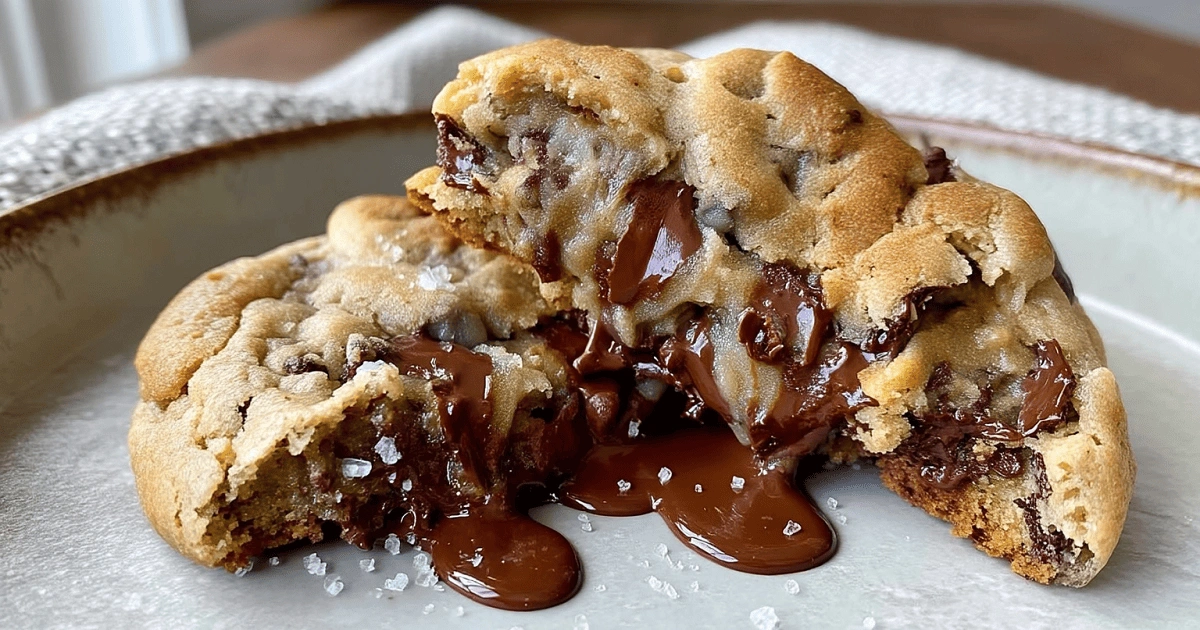
FAQ Section: Chocolate Chip Cookies FAQs Answered
To make gooey chocolate chip cookies, use cold butter, a touch of cornstarch, and a high baking temperature (475°F). This combo keeps the cookie tall and the center soft. Remove them from the oven just as the edges set and let them rest on the tray to finish baking from residual heat.
Cookies often spread too much because of soft butter, too little flour, or an overheated baking sheet. Using cold butter and the right flour ratio helps maintain thickness, while baking on parchment prevents overbrowning and spreading.
Too much flour, cold dough, or an under-creamed butter-sugar mix can cause cookies to stay thick and puffy. Ensure accurate flour measurements and room-temp-ready dough to allow for natural spread in the oven.
Yes! Pre-scoop the dough into balls and freeze them. When ready, bake directly from frozen at 475°F, adding 1–2 minutes to the normal bake time. This method produces cookies with tighter structure and richer flavor.
Conclusion: Master the Ultimate Chocolate Chip Cookies at Home
Baking thick, gooey chocolate chip cookies isn’t about luck it’s about understanding the science behind ingredients, technique, and heat. Whether you’re aiming for bakery-style centers, crisp edges, or freezer-ready batches, this guide has armed you with every tool to bake with confidence.
From troubleshooting spread issues to upgrading your flavor profile with brown butter or sea salt, you now have everything you need to elevate your cookie game. Make them once, and they’ll become your go-to recipe for life.
Don’t miss our Strawberry Cheesecake Dump Cake for another easy, crowd-pleasing dessert that’s packed with texture and flavor.
